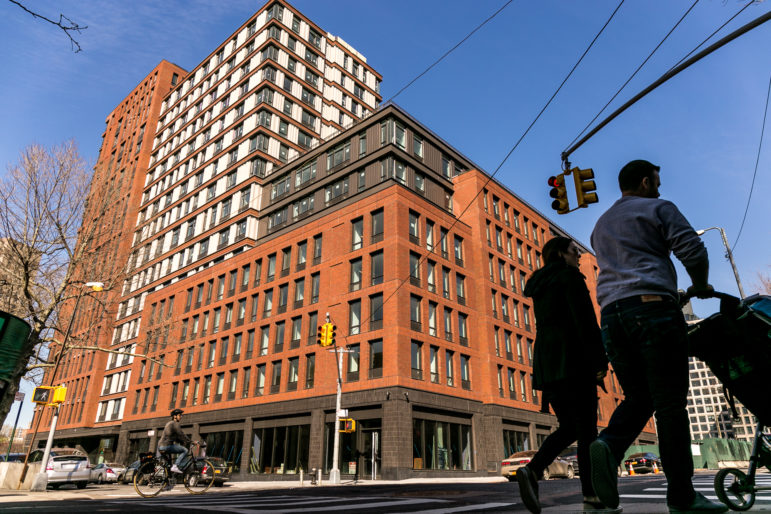“Fully funding Section 8 to establish a Universal Housing Voucher program will clear the way to reduce spending on everything from health care to food security, and set a course to end this housing crisis.”

Adi Talwar
There are conversations taking place every day among our elected representatives, from the U.S. Capitol to our local town halls, about how to solve the housing crisis that worsens every year.
This summer showed the urgency for solutions as record high temperatures swamped the nation, taking a devastating toll on our homeless neighbors. As previously unprecedented weather and climate events become regular occurrences, looming threats of disasters have the potential to make hundreds of people homeless overnight.
This is is a complex problem with no simple answer, and just as numerous causes led to our current housing crisis, numerous solutions need to work in concert to stem the tide. Leadership and adequate investments must start at the top. We need a nationwide, federal commitment that matches the scale of the crisis to help all Americans secure affordable, good quality housing.
This commitment could take many forms, from innovative bipartisan tax incentives like the Neighborhood Homes Investment Act and the Affordable Housing Tax Credit Improvement Act, which would help boost production of new housing and ramp up preservation of existing housing, to increased appropriations for public housing and rental assistance programs that directly support those most at risk of housing insecurity.
This crisis is too dire for too many people. The federal government must act with urgency now.
For the one-in-three households in the U.S. that rent, the need is particularly urgent. Last year, rental prices saw the fastest growth on record across multiple housing sectors, with rents in 116 of 150 of the nation’s largest metro markets growing by double digit percentages and by more than 20 percent in 25 of those markets. Today, nearly one-in-four renters are spending at least half their earnings on housing with little left for other necessities, leaving millions teetering on the edge of homelessness.
For some, help comes in the form of a housing voucher. Since it was created in 1978, the Housing Choice Voucher Program has helped eligible low- and moderate-income families by capping their rental costs at 30 percent of their earnings. Today, more than 3 million U.S. households benefit from rental assistance vouchers either directly through the program or as renters in affordable homes financed by the consistent revenue the vouchers provide.
While there’s a long history of reducing voucher holders to unfavorable stereotypes, the reality is the folks who benefit come from every walk of life. They’re our nurses, our firefighters, our teachers, our bus drivers. They live in every community and every type of housing, from rural single-family homes to suburban townhouses. These are hard-working people who are doing everything asked of them, but are still struggling to get by.
Despite its proven track record of positive impact, the Housing Choice Voucher program remains woefully underfunded, covering just one-in-four eligible renters nationwide. That leaves some 16 million households on the outside looking in, often on waiting lists for years as they fight to avoid homelessness. Simultaneously, landlords have become frustrated with the inefficient and cumbersome administrative requirements, and wary of annual appropriation battles.
With so many American families on the edge of homelessness, we simply cannot afford to spend so little of our nation’s more than $6 trillion budget on a program we know works. By tripling annual spending on the Housing Voucher Program to $100 billion annually, still less than 2 percent of the federal budget and about one-tenth of what we spend on Social Security, we can make housing vouchers universally available to all eligible households. This investment could help the program lift an estimated 2.2 million additional families out of poverty while providing low-income renters a new level of tenant protections and housing quality standards.
Inaction is costly. When you add up the tab for the myriad federal, state, and local services that support the unhoused, studies show a chronically homeless person costs taxpayers as much as $30,000 to $50,000 each year. Fully funding Section 8 to establish a Universal Housing Voucher program will clear the way to reduce spending on everything from health care to food security, and set a course to end this housing crisis.
We can’t stop there. Government must also address our crippling housing undersupply if we’re going to make long-term progress. Post-World War II, facing a huge housing shortfall, government-subsidized development fueled economic growth that increased supply and led to deeper affordability. Today, sky-high interest rates and costs have stymied development. Our elected leaders have the opportunity to learn from the past, and can take action to make housing production the focal point of our economic resurgence.
Congress must take an “all of the above” approach, and move swiftly to pass legislation like the Affordable Housing Tax Credit Improvement Act, the Neighborhood Homes Investment Act, and the Community Development Investment Tax Credit Act to boost the production of new housing and preservation of existing affordable housing.
Such transformative public investment in rental housing affordability and supply would be in many ways analogous to a homeowner’s down payment on a house: An upfront investment that unlocks long-term stability, opportunity, and, most importantly, affordable homes for millions of Americans—returns that will be realized for generations to come.
Rafael Cestero is CEO of the Community Preservation Corporation (CPC) and co-host of The Housing Problem podcast. He was commissioner of the New York City Department of Housing Preservation and Development (HPD) from 2009-2011.








